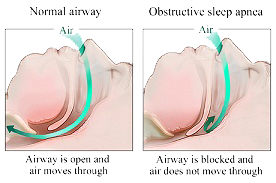Obstructive sleep apnea is a condition in which the flow of air pauses or decreases during breathing while you are asleep because the airway has become narrowed, blocked, or floppy.
A pause in breathing is called an apnea episode. A decrease in airflow during breathing is called a hypopnea episode. Almost everyone has brief apnea episodes while they sleep.
Causes
 All of the muscles in your body become more relaxed during sleep. This includes the muscles that help keep the airway open and allow air to flow into the lungs.
All of the muscles in your body become more relaxed during sleep. This includes the muscles that help keep the airway open and allow air to flow into the lungs.
Normally, the upper throat still remains open enough during sleep to let air pass by. However, some people have a narrower throat area. When the muscles in their upper throat relax during sleep, their breathing can stop for a period of time (often more than 10 seconds). This is called apnea.
The snoring in people with obstructive sleep apnea is caused by the air trying to squeeze through the narrowed or blocked airway. However, everyone who snores does not have sleep apnea. Other factors may also increase your risk:
- A lower jaw that is short compared to the upper jaw (retrognathia)
- Certain shapes of the palate or airway that cause the airway to be narrower or collapse more easily
- Large tonsils and adenoids in children that can block the airway
- Large neck or collar size (17 inches or more in men and 16 inches or more in women)
- Large tongue, which may fall back and block the airway
- Obesity
Treatment
The goal is to keep the airway open so that breathing does not stop during sleep.
The following lifestyle changes may relieve symptoms of sleep apnea in some people:
- Avoiding alcohol or sedatives at bedtime, which can make symptoms worse
- Avoiding sleeping on the back may help with mild sleep apnea
- Losing weight may decrease the number of apnea spells during the night
Continuous positive airway pressure (CPAP) is now the first treatment for obstructive sleep apnea in most people. CPAP is delivered by a machine with a tight-fitting face mask.
Many patients have a hard time sleeping with CPAP therapy. Good follow-up and support from a sleep center can often help overcome any problems in using CPAP.
<?php include ‘http://www.smileident.com/sidemenu.php’; ?>